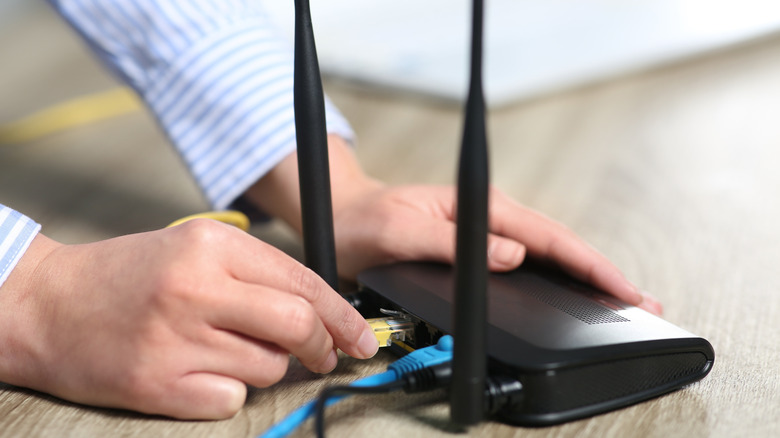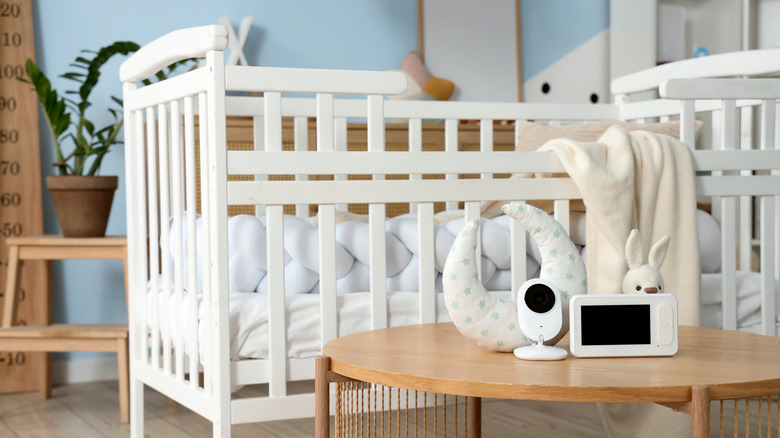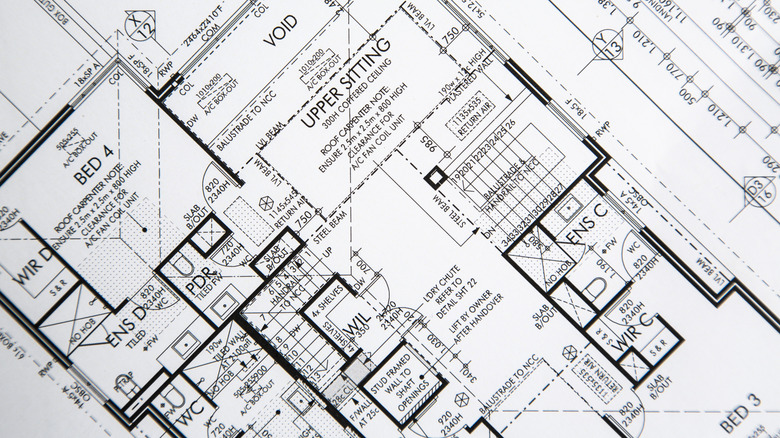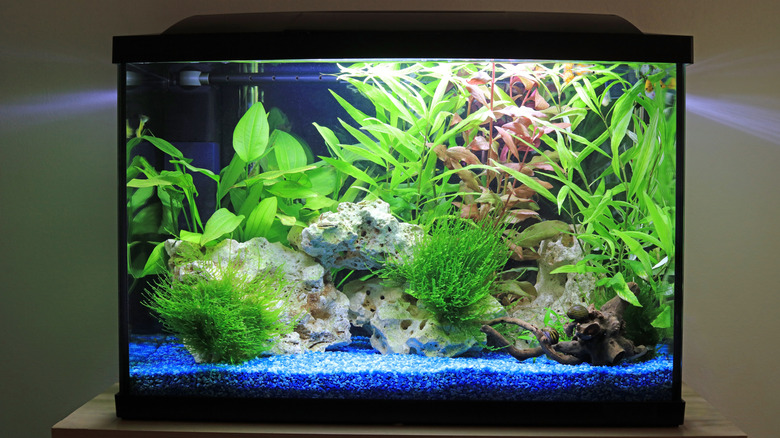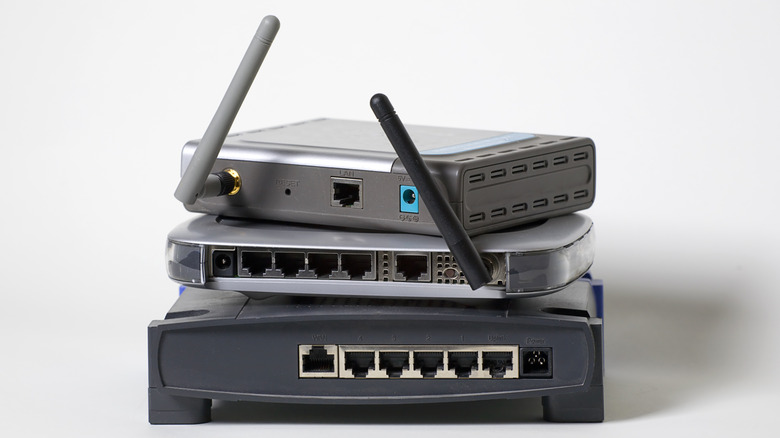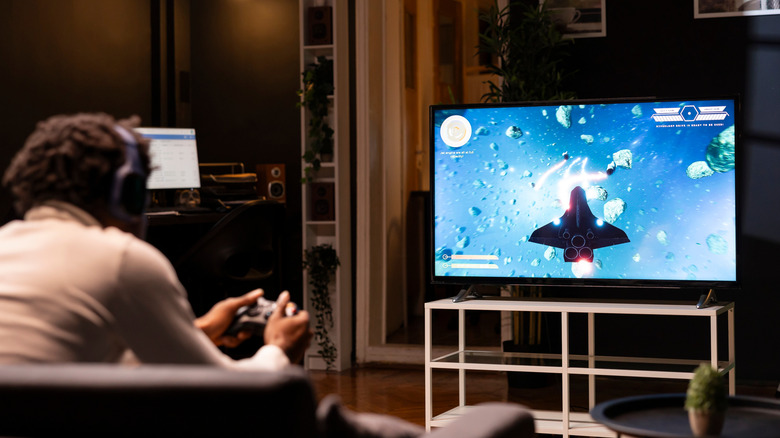8 Things In Your Home That May Be Ruining Your Wi-Fi Connection
Wi-Fi, much like printers, for some reason requires an infuriating amount of troubleshooting despite being a relatively simple and straightforward technology. You'd think that as long as you have a paid plan with your ISP, you should be able to plug it in, and voilà. Instead, it might not be working for any of a million reasons; perhaps it's one of the most common reasons your Wi-Fi is down, perhaps the Wi-Fi router itself is limiting your speeds, or perhaps even the whole headache was because of one Wi-Fi setting making your games lag. It definitely makes you wonder how airplanes offer Wi-Fi in the sky when your router down on earth stops working without constant divine intervention. In some cases, though, it may not be the Wi-Fi. It might be the contents of your house.
Your router has its work cut out for it. The average home presents an obstacle course full of materials that deflect, absorb, and block fragile Wi-Fi signals. If you're running into dead zones, weak spots, or generally poor Wi-Fi connectivity and strength, there's a good chance your router is in a bad spot, or something in its line of fire is interrupting the signal. The following eight things in your home may explain an unsatisfactory Wi-Fi connection.
Putting your router in the wrong place
It's common practice to squirrel your router away, out of sight, in some cluttered corner of your house — all of which could ruin your Wi-Fi signal. Go for the most obvious improvement first: relocating your router to a more centralized location, if possible, where it's serving the most-used areas of your home. Another mistake is putting the router on the floor rather than higher up; think of your router like a radio tower that needs elevation to better broadcast its signal far and wide, with minimal obstructions.
Ideally, you shouldn't conceal your router. Leave it out in the open, even if your inner decorator hates it. Confining it to a crowded wooden cabinet with other items could weaken the signal. Worse, cooped-up routers overheat and perform worse. If it's an offense to God and man to leave your router visible, then hide it in a thin, non-metallic material. Think wicker basket or cubic organizer, not a metal bin or wooden cubby.
Also, avoid the temptation to put it in some out-of-the-way location, like behind a couch or in your basement. We cannot stress enough the importance of keeping your router central, elevated, and unobstructed. If possible, mount your Wi-Fi router on the ceiling. Provided it's not too much of an eyesore, it'll improve signal strength while reducing clutter. To extend Wi-Fi range outside your home, extenders or your old Wi-Fi router can help, but expect reduced performance and increased latency.
Microwaves, security cameras, and baby monitors
You'd be surprised how close Wi-Fi routers sit on the electromagnetic spectrum to the signal traffic of other common household devices. For example, microwaves really do interfere with Wi-Fi. That shared 2.4GHz frequency band is both cooking your food and letting you rewatch "The Sopranos." Even when the microwave isn't on, it's best not to place your router near metal appliances like refrigerators.
Other items operate on that same spectrum, such as baby monitors, security cameras, and cordless landline phones. If you've got a little one on the way, try a 900MHz baby monitor to reduce interference. Wireless security cameras may need to be shunted to a different band that doesn't interfere. If you're still rocking a cordless phone, consider a newer model that supports a less common frequency band like 1.9GHz or 5.8GHz. Oh, and consider putting up fewer Christmas lights; those interfere with Wi-Fi, too.
Keep in mind, the above only applies to the 2.4GHz frequency band. Most routers today support 2.4GHz and 5GHz Wi-Fi, the latter being faster and higher-bandwidth. It's recommended to use 5GHz for mobile devices and computers since it's more stable and reaches gigabit speeds, but smaller IoT devices (like smart lights) often rely on the longer-range 2.4GHz — meaning they're most likely to suffer interference. Try shifting more devices to the 5GHz band if you can't reduce the interference on the 2.4GHz band; the only significant disadvantage with 5GHz is its reduced range.
Walls (especially concrete or brick)
A far bigger impedance than anything mentioned so far is the walls of your home. Even thin walls that let you hear your neighbor's every pin drop can deflect and dampen Wi-Fi signals — so much so that scientists have figured out how to use bounced signals to see people through walls. Download Wi-Fi analyzing tools to diagnose your home internet issues and you'll notice immediately how walls limit network reach; the more walls between you and the router, the worse your signal. You can't get rid of your walls, but you can understand how they affect your internet and what exactly you need to do to compensate.
First, know what your walls are made of. You lost the Wi-Fi lottery if your home has concrete or brick, since these dense materials criple a good signal. You might need Wi-Fi range extenders or a mesh network to boost coverage. If push comes to shove, you could try a DIY method like this aluminum foil hack to fix weak Wi-Fi. Homes with wood and drywall won't pose as much of an obstacle as brick and concrete.
Back router placement: This is why it's unwise to place your router against a wall, in a corner, or at one end of the house far from where most people use Wi-Fi. Walls and Wi-Fi don't mix. You might consider the best Cat-8 ethernet cables for home networking to bring internet to those areas of your home blocked by multiple walls.
Metal objects (including mirrors and windows)
Walls aren't great for Wi-Fi, sure, but Wi-Fi's true mortal enemy is metal. Metal is the material of choice for deflecting electromagnetic waves. Case in point: You can make a Faraday cage that blocks signals by wrapping your phone in three layers of aluminum foil. You can probably guess what metal does to Wi-Fi signals. Simply placing a router in a wire mesh bin is enough to degrade performance. The tip is simple: Avoid placing your router near large metal objects.
This includes metallic decor and furniture — filing cabinets or that artsy welded-metal decoration could be why you're not getting a strong signal in the room behind it. Metal is also why you shouldn't hide your router in a closet blocked by a water heater, washing machine, or other large appliances. Chicken wire in the walls, particularly in modern houses, could also weaken the signal. So if your router's in the corner of your office, blocked off by your metal-rich desktop tower and metal computer table, you know why your Wi-Fi sucks.
However, there are two metal-containing objects that you probably never think about: mirrors and windows. Mirrors are just thin reflective metal behind glass. Low emission (also called "low-e") windows use microscopic metallic oxides that are transparent but deflect UV rays. Placing your Wi-Fi router right beside a low-e office window, or close to a big decorative mirror, could disrupt the signals and reduce performance for anything on the other side of them.
Water features (like fishtanks)
Similarly good at blocking electromagnetic signals is water. Wireless data can't travel through H2O because water absorbs most electromagnetic radiation, save visible light. That's why submarine crews are cut off from the world when submerged, unless they use complex, unconventional means of transmitting data through water. Spoiler alert: Wi-Fi also fails hard when it hits water. Household water features like pipes and washing machines can impede Wi-Fi signals. So definitely don't put your Wi-Fi router close to a water heater — a double whammy of metal and water. It's also unwise to put it near heavy plumbing, like a utility closet or indoor jacuzzi.
Another potential blockage — one you likely didn't expect — is your fish tank. Now, this isn't to say that your tiny fishbowl is the reason why Netflix isn't streaming in 4K. We're talking about aquariums that take up significant space. Depending on where your router and fish tank are located, it could explain poor signal in certain areas.
That said, some argue fish tanks don't cause serious Wi-Fi issues. Unless your router's within a few feet of the tank, it's likely no worse than obstructions like mirrors or microwaves. Regardless, it is something to keep in mind when diagnosing issues with a Wi-Fi analyzer and choosing a router location. If your fish tank is creating an unexpected dead zone or interrupting line-of-sight for important IoT devices, it might be time to relocate those turtles.
Other Wi-Fi networks
Wi-Fi's own worst enemy may be another Wi-Fi network, ironically. It's been a concern for decades that a lack of regulation for 2.4GHz could make for a network congestion nightmare in urban areas. Even with modern Wi-Fi standards, which more effectively switch channels to avoid interference, neighboring Wi-Fi routers could cause each other to perform worse.
Obviously, there's not much you can do about reducing interference from your neighbor — unless the two of you are chummy enough (and tech-savvy enough) to agree to keep to separate Wi-Fi channels. If you're getting really bad interference that you suspect is from your neighbor's nearby router — perhaps they've positioned theirs right against a wall facing yours — try relocating your own. Some of the best Wi-Fi routers that won't break the bank include 6GHz bands, which may further reduce overlapping channels.
If you have more than one home network, then it behooves you to make sure both of them are running on separate channels. Try to stick with 5GHz as much as possible, since this has more channel options to reduce interference; using primarily 5GHz could make interference from a neighbor more bearable, too, since channels will be less likely to clash. Also, be wary of how other devices could be impacting your network. Turning on the hotspot on your iPhone, for example, could cause a disruption for other devices, especially if you enable the 2.4GHz Maximize Compatibility mode.
Bluetooth devices
The modern home is bursting at the seams with Bluetooth-enabled devices, from smartphones to smart TV boxes, to speakers, to game consoles, to peripherals — you get the idea. Like microwaves and baby monitors, Bluetooth sits on the 2.4GHz band, same as 2.4GHz Wi-Fi. Too many concurrently running Bluetooth devices could be the reason why your 2.4GHz network is faring poorly. Our first recommendation: Avoid clustering too many devices together; I've noticed, anecdotally, how having one too many Bluetooth items near my computer (peripherals, headphones, etc.) causes all of them to perform worse.
Where possible, try to limit Bluetooth traffic. If a device isn't using (or doesn't need) Bluetooth, then turn it off. Heavy-usage Bluetooth devices, like a pair of headphones, should be plugged in directly if possible; I've personally seen how switching a wireless headset to wired suddenly makes all my internet problems vanish. Many Bluetooth peripherals, like mice and keyboards, support 2.4GHz mode — which reduces interference and improves the peripheral's performance. For example, a Logitech mouse and keyboard can likely connect to the same unifying receiver to cull traffic.
Remember, that 5GHz Wi-Fi connection on your router is more stable and supports more channels. Think of it like an emergency release valve that can take the pressure off a bloated 2.4GHz network. Connect as many devices to it as you can. Also bear in mind that some USB 3 and Thunderbolt devices, if not properly shielded, could be causing interference when nearby.
TVs
It's common to see Wi-Fi routers near TVs, since that's usually where your TV gets its cable connection. Such a configuration even seems ideal, since you want the router as close to the TV as possible to ensure a direct, clean connection to stream things in glorious 4K. If you're noticing poor network performance, however, then the TV may shoulder some of the blame.
It doesn't take a PhD in electromagnetic radiation to guess why. TVs are filled with metal, and modern smart TVs with Bluetooth especially are occupying similar frequency bands. Even old display units with outdated tech, like CRTs, throw off EMF radiation. If you thought you were saving space and hiding your router by putting it behind the TV, now you know it might be best to put it elsewhere.
Unfortunately, placing your router underneath the TV is just as bad. When in doubt, relocate your router to a decent remove from your television — six feet, at least. Remember, it's not just about interference from metal and appliances. A closed, below-TV cabinet enclosure could be degrading your Wi-Fi signal and preventing it from releasing heat. If you're still getting a bad signal, then you may need to reposition the antennas. There's a very good chance your Wi-Fi router antenna is pointed wrong.

